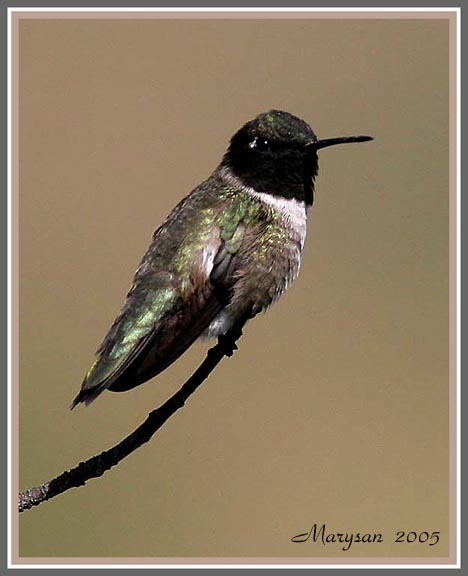(reformat text area) |
(add photo of female) |
||
| Line 1: | Line 1: | ||
;Archilochus alexandri | ;Archilochus alexandri | ||
[[Image:Black-chinned_Hummingbird.jpg|thumb|550px|right|Photo by Marysan]] | [[Image:Black-chinned_Hummingbird.jpg|thumb|550px|right|Photo by Marysan]] | ||
| + | [[Image:Black-chinned_Hummingbird_fem.jpg|thumb|450px|right|Photo by HelenB<br/>Location: Davis Mountains, W. Texas, USA]] | ||
==Identification== | ==Identification== | ||
| − | 3 1/4-3 3/4" (8-10 cm). A small hummingbird. Male green above with iridescent black chin underlined by violet-purple throat band. Female green above with white throat and breast, buff sides, and white-tipped outer tail feathers. In East, female | + | 3 1/4-3 3/4" (8-10 cm). A small hummingbird. Male green above with iridescent black chin underlined by violet-purple throat band. Female green above with white throat and breast, buff sides, and white-tipped outer tail feathers. In East, female difficult to distinguish in field from female Ruby-throated. Structure like Ruby-throated: slender, small-headed, and thin-necked. Female distinguished from similar species by overall shape, long bill, flat forehead, drab grayish color and longer wings with distinct club shaped primaries. |
==Distribution== | ==Distribution== | ||
| − | Breeds from British Columbia south throughout West to Mexico and central Texas. Winters in Mexico. | + | Breeds from British Columbia south throughout West to Mexico and central Texas. Winters in Mexico, though a small number of Black-chinned winter along the Gulf Coast of the USA. |
==Taxonomy== | ==Taxonomy== | ||
Revision as of 02:10, 4 July 2007
- Archilochus alexandri
Identification
3 1/4-3 3/4" (8-10 cm). A small hummingbird. Male green above with iridescent black chin underlined by violet-purple throat band. Female green above with white throat and breast, buff sides, and white-tipped outer tail feathers. In East, female difficult to distinguish in field from female Ruby-throated. Structure like Ruby-throated: slender, small-headed, and thin-necked. Female distinguished from similar species by overall shape, long bill, flat forehead, drab grayish color and longer wings with distinct club shaped primaries.
Distribution
Breeds from British Columbia south throughout West to Mexico and central Texas. Winters in Mexico, though a small number of Black-chinned winter along the Gulf Coast of the USA.
Taxonomy
Habitat
Mountain and alpine meadows, woodlands, canyons with thickets, chaparral, and orchards.
Behaviour
Nesting: 2 white eggs in a nest of fluffy plant wool and lichens woven together with spider webs, placed in a shrub or low tree.
Voice: A low tup.
The male Black-chinned, like all hummingbirds, maintains a mating and feeding territory in spring. He courts his female with a dazzling aerial display involving a pendulum-like flight pattern. When mating interest wanes, the male often takes up residence elsewhere, near a good food supply. Later, when plant blooming and insect swarming subside, the birds move south.





